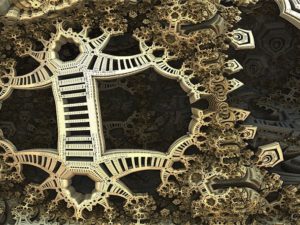
By Vajra Chandrasekera
The Man Who Spoke Snakish — Andrus Kivirähk (Grove Press UK), translated by Christopher Moseley
 The Man Who Spoke Snakish is easily the least traditionally science fictional of my shortlist selections: not only does it feature no rockets, but it’s set firmly in the past (and is more about pasts than futures) and it includes talking snakes and something very much like a dragon. In the sense that science fiction is defined by the presence or absence of received ideas and familiar imagery—that is, using the least science fictional definition of science fiction—it would not be considered science fiction.
The Man Who Spoke Snakish is easily the least traditionally science fictional of my shortlist selections: not only does it feature no rockets, but it’s set firmly in the past (and is more about pasts than futures) and it includes talking snakes and something very much like a dragon. In the sense that science fiction is defined by the presence or absence of received ideas and familiar imagery—that is, using the least science fictional definition of science fiction—it would not be considered science fiction.
Science fiction is traditionally associated with imagining futures, but that mechanism is time-symmetric: it is also frequently used to imagine the past, though usually in contained forms like alternate histories or time travel. But it seems perfectly reasonable to apply the same techniques of imagining the far future to imagining the far past. This symmetry makes sense, since the past is exactly as (un)real and (in)accessible as the future. Both are constantly being produced and reimagined, not separately but together. This future of rocket-ships exploring the galaxy and colonizing strange new worlds is simultaneously imagining a past where Europe “explored” Earth and “colonized” strange new lands. That future of first contact where humanity is tested for worthiness by strange wise aliens is simultaneously imagining a past where first contacts were uplifting, or at least could have been if only the restless and doomed natives had had an Amy Adams to hold up a sign with human written on it.
The Man Who Spoke Snakish is set in medieval Estonia and follows the life of Leemet, a boy who eventually becomes the last living speaker of Snakish, which is a once-widespread primordial language in which animals can be commanded and compelled. (Which, incidentally, is a device that previously showed up on Clarke shortlists in a more conventionally sfnal form in 1994—and no doubt in other instances too, this is just the one that sprang to mind—when Neal Stephenson handwaved about Sumerian as a primordial and programmable language for human cognition, or something. The distinction between the two seems superficial to me, relying largely on the interior décor. Science fiction is the one that goes beep.)
Leemet is one of the last generation of his forest-dwelling people, who are either dying out or leaving the forest to assimilate into villages, learning German, Christianity, and agriculture at the expense of Snakish. The world outside the forest is an alien one of Christian monks and knights in armour. The Pope is a distant but threatening presence, like a Borg Queen in a neighbouring quadrant. Leemet spends his entire life working out his relationship with modernity—he is attracted and repelled by it, he commits violence against it, he becomes resigned to it, he resents it bitterly but also yearns for it. Much of this he’s inherited from his family:
Uncle Vootele told me how my father—when he was still living in the forest—would just about explode with irritation and envy when he thought about the interesting life the villagers were leading and the impressive tools they had.
“We must hurry up and move to the village!” he had shouted. “Life is passing us by! These days all normal people live under the open sky, not in the bushes! I want to sow and reap too, as they do everywhere in the developed world! Why should I be any worse? Just look at the iron men and the monks; you can see straight away that they’re a hundred years ahead of us! We must make every effort to catch up with them!”
The conflict between the eternal and progressive views of time is the rod around which Leemet twists. The modern view of time is that there is such a thing as a future: that there is development, that there is progress. The iron men and the monks are not just an invading civilization from the future: they bring with them the very concept of a future (and therefore of a past), and place themselves at its teleological heart. The arrival of alien ships looking for Christians and spices assert a new sense of time, one whose lines are not parallel and therefore have a vanishing point—one, always, that privileges the alien point of view, putting the arrived-upon on the back foot. As Johannes the determinedly modern villager says to Leemet:
I was taken to Rome and led in front of the Pope, and the glory and splendor I saw there took my breath away. Gold, silver, and precious stones were glittering everywhere; the churches were made of stone and with such high towers that not a single spruce tree here in the forest could reach them. Then I understood that the God that is served by the foreigners is the most powerful, and if we want to achieve anything in life, then it is wise to turn to him and to forget all the silly superstitious customs that make us ridiculous before the whole world. I came back home and was ashamed that we still live like children, while other nations have grown into adults.
These violent futures conjure violent pasts, which Leemet resists in turn. This isn’t a story about clinging to tradition against change: rather, traditions are invented only in response to change, quantum pasts flickering into being to cancel out new futures. Traditions and heritages are just as new, just as suspicious, as progress and development. (Sri Lankan Theravada Buddhism, for example, was retroactively invented as a 2,300-year-old tradition in the eighteenth and nineteenth centuries. As a form of anticolonial resistance, yes, but one built explicitly along casteist and ethnic lines: that is, rooted in both the native bigotries and the imported ones, the worst of both worlds. It’s instructive—and depressing—to compare it against the more recently, and carefully, constructed Buddhism of Ambedkar.) In Snakish, Leemet is constantly encountering new pasts:
Hiie had another problem too, apart from having to feed wolves all day long and chop up hares with a big ax. She didn’t drink wolves’ milk—and that was extremely bad, in Tambet’s opinion. Think of the pack of wolves squatting in the barn, lactating rivers! What was to be done with all that milk? Naturally it had to be drunk, and every family member had to make a contribution. Apart from that purely practical reason, Tambet was deeply convinced that every true Estonian ought to drink wolves’ milk; it was wolves’ milk that had given our forefathers and foremothers their boundless strength. So refusing wolves’ milk was a terrible crime, a betrayal of old customs, and in Tambet’s opinion nothing was more heinous.
Tambet loathes the village and everybody who moves there. His traditions are produced by his anxiety about the modern: the presence of the village outside the forest is what brings them into being and makes them real. Tambet’s friend and ally Ülgas the Sage persistently constructs a past where the Sages of the Grove and the worship of sprites are central to the culture of the forest-dwellers—a past contested by Leemet and his uncle Vootele, who don’t believe in sprites at all, much less the sages.
Only later did I understand that although Ülgas and Tambet hated all those who had settled in the village, they themselves no longer really lived in the forest. They were disappointed and angry to see the good old sylvan life gradually dying out, and to overcome that they clung to the especially ancient and secret ways. They cherished spells, sought a way out in the invented world of the sprites, and no longer cared for ordinary Snakish words. To them they seemed too weak; they had not been able to keep people in the forest, so must be of no use.
Snakish itself is a source of multiple pasts. It isn’t the language of snakes as such, but the language of the entire animal kingdom, of which adders are the pinnacle and Snakish-speaking humans are a sort of benighted cousin. It is not a human technology, but an adder technology (indistinguishable, of course, from magic) that humans once practised and which was lost through generations of disuse. It’s not the only thing that was lost through disuse; Pire and Rääk are the last living Primates, hominids who still have vestigial tails, and Leemet’s terrifying grandfather still has the poison fangs that were once common among humans. All of them are constantly inventing pasts, and Pire and Rääk are perhaps the most committed to regression:
Likewise the Primates Pirre and Rääk were still in the forest, though they no longer lived in their old cave, but had moved to a tree. That is, in their love of antiquity they had gone so far that even living in a cave seemed senselessly modern to them […] they were no longer young; their fur was gray and it was very troublesome for them to keep their balance on the branches. In the name of their principles, however, they were prepared to undergo any trial.
Pire and Rääk speak a dialect of Snakish older than the one Leemet does, which requires pronounciation that Leemet’s tongue is physiologically unable to reproduce. The Primate Snakish commands a wider variety of animals, and harkens back to ever more ancient eras. The paintings on the walls of the Primate cave go back hundreds of thousands of years, but the oldest ones are long lost to cave-ins so Leemet only has Pire and Rääk’s assurances that they even exist, much less what they depicted.
Of all that is lost, the most remarkable are the great monstrous creatures of ancient times who Leemet observes passing into myth. One is the great winged snake called the Frog of the North, who could once be commanded to destroy invading armies by thousands of massed Snakish speakers but now only sleeps. Leemet spends much of his life searching for the Frog of the North, and eventually becomes the sleeping dragon’s guardian, but cannot wake him: a single speaker of Snakish is not enough. Leemet is the last person to know that the Frog of the North is real. Leemet and his friend Hiie also briefly encounter a monstrous giant fish called Ahteneumion, who is “as big as a mountain, and evidently terribly old, for the whole sea was full of its long gray whiskers”, and who decides after a brief conversation that he will never rise from the ocean floor again but will follow the example of the Frog of the North in sleeping forever. Before diving for the last time, the fish tells them:
“You were the last humans I saw and who met me. You know who Ahteneumion is and what he is doing. Others don’t. You are now the wisest people on earth. The last ones to see me. Farewell!”
To Ahteneumion, history centres on himself, and effectively ends with his abdication of it—a charmingly simple egoism that Leemet aspires to but can never attain, even when he becomes the last speaker of Snakish left alive.
While the story begins from Leemet’s early childhood, it’s clearly indicated right from the beginning that this is a much older Leemet looking backwards. It has the feel of a told tale, full of digressions, commentary, and opinions. It is also that fundamentally modern thing: memoir. This isn’t the book of Leemet living his life, but rather of the older Leemet telling, in retrospect, the story of his life. He is narrating it, creating it, trying to make it make sense, to give it a shape, making selfhoods and shedding them. His life is resistance to modernity, but his narration of his life is the degree of his assimilation to it.
Snakish gives Leemet a consistent, wry, casual tone, unselfconscious and unaffected. There are some anachronistic jokes (for instance, once referring to a bear as a “teddy” in a pre-Roosevelt setting) which are in keeping with the tone but didn’t quite land for me. Snakish doesn’t take itself too seriously: all the death and loss and violence is accompanied by lots of pure comedic moments like the giant louse who behaves like a dog, or how anything Leemet’s grandfather does is inevitably both extremely violent and extremely funny. On the other hand, for the most part all the women in this book are caricatures who exist to give Leemet something to react to—his mother’s histrionics and overfeeding; Magdaleena the beautiful village girl slash temptress, Hiie the playmate turned love interest and so on—and who mostly die so that he can feel things. So there’s that. Even more tiresomely, a female adder is more of a character than any of the human women, and even she (literally) takes maternity leave from the plot halfway through.
A recurring motif throughout the story is the stench of death, which is a memory from a traumatic experience in his childhood (the death of his uncle Vootele) that Leemet associates with loneliness, abandonment, and alienation, and which eventually becomes the manifestation of his anxiety around modernity. He smells decay even while the villagers openly admire his command of Snakish, because he still believes that Snakish is a learnable language, the common heritage of all humans and not a special power that he alone now possesses. Unlike Ahteneumion, Leemet understands that history has left him behind: or rather, he understands that he now lives inside “history”, and that there’s no place for him in it specifically because it was made for somebody else. Leemet’s climactic rampage of violence is understood to be pointless from the beginning. It’s not a great war of liberation or a final battle between good and evil; it’s just a paroxysm of violence born out of frustration and rage. It is cruel, ridiculous, and unnecessary, and therefore quite authentic. On a more individual scale, though, the story does suffer from the sheer cavalcade of tragedies. So many people in Leemet’s life die suddenly and horribly that one comes to expect it a little too soon, which is possibly why I found myself sometimes impatient for the story to get a move on.
One way in which this is not a Tolkienesque melancholy narrative of a golden age resisting modernity, to which it might bear a superficial resemblance: the pasts in Snakish are multiple, contingent, self-serving. There is no actual golden age: each character invents their own past and implied future, or vice versa, and their competing visions are destabilizing, alienating. Ahteneumion sees the end of history right then and there as he goes to sleep. Johannes sees history as an upward curve of development and progress, much as it is fantasized in history textbooks today. Pire and Rääk see a dizzyingly elongated curve in the other direction, a very long slippery slope of loss. They respectively place history’s end at the opposite ends of time. The text is openly sympathetic to Pire and Rääk’s perspective, even when Leemet doesn’t agree with their gentle, inward-focused devotion to regression. They are the only characters whose movement along any curve of history seems worth cheering for, even if it’s in the “wrong” direction. Pire and Rääk set out on a mission to climb back up the slippery slope and personally undo the losses they see in history; it’s fitting that they get a more elegiac ending that Leemet himself does.
*
Vajra Chandrasekera is a writer from Colombo, Sri Lanka, and a fiction editor at Strange Horizons. His short fiction has appeared in Black Static, Clarkesworld, and Lightspeed, among others. He blogs occasionally at vajra.me and can be found on Twitter at @_vajra.
>> Read Vajra’s introduction and shortlist.


